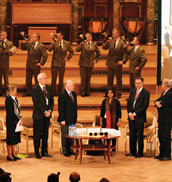Enhancing the role of forests in
mitigating and adapting to climate change
|
 |
Building momentum on the road to Copenhagen
Although deforestation is responsible for one-fifth of global carbon emissions, international agreements designed to tackle climate change have so far avoided the issue. This is all set to change. The current climate change negotiations recognise that forests must be part of the solution to reducing emissions. And that reducing deforestation should benefit not just the climate, but also poor rural people and biodiversity conservation. This was the key message to come out of ‘Forest Day 2’, an event co-hosted by CIFOR at a UN climate change conference in Poland.
more
|
 |
REDD: an idea whose time has come
‘The idea of REDD is quite simple,’ says Arild Angelsen, a CIFOR senior associate based
at the Norwegian University of Life Sciences. ‘It involves channelling money from the global community to forest users, and making forest conservation more profitable than the conversion of forests to agriculture and other uses.’
more |
 |
Forests for adaptation and adaptation for forests
When they talk about climate change and forests, people largely think in terms of mitigation. By planting trees we can mitigate climate change by mopping up some of the atmospheric carbon. And by curbing deforestation and forest degradation, we can reduce the emissions going into the atmosphere. We have paid much less attention to forests and adaptation: devising ways through forest management to help human communities and the natural world cope with climate change.
more |
 |
Industry challenges conservationists to raise the bar
There are two ways forests are being enlisted in the struggle against global warming. One is preventing deforestation and forest degradation, which release carbon into the atmosphere. The other is planting trees to absorb or sequester carbon dioxide. Projects to manage forests in ways that mitigate climate change also have the potential to deliver significant benefits for communities and wildlife. CIFOR has been helping the Climate, Community and Biodiversity Alliance (CCBA) to devise standards to assess the quality of projects like these. more |